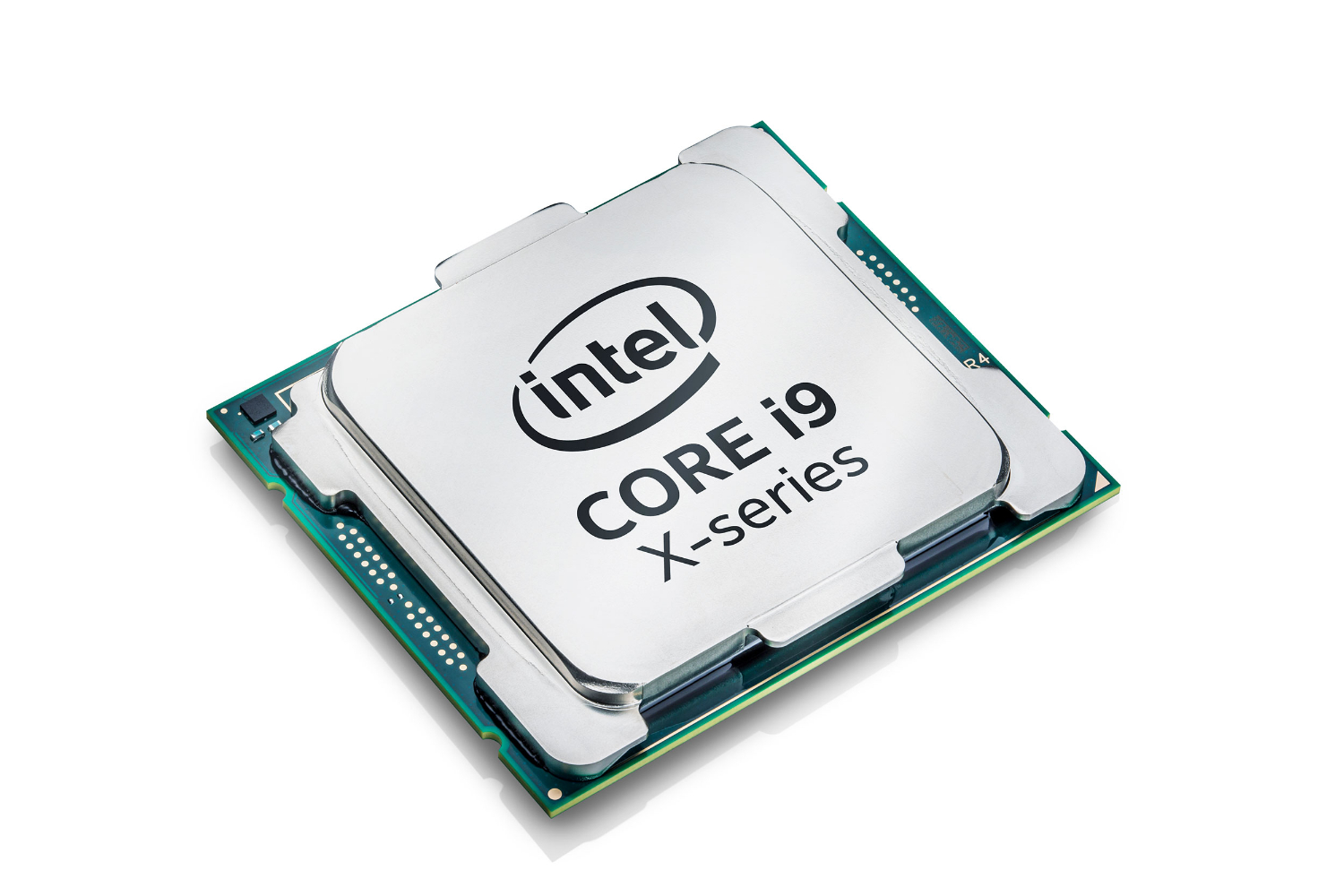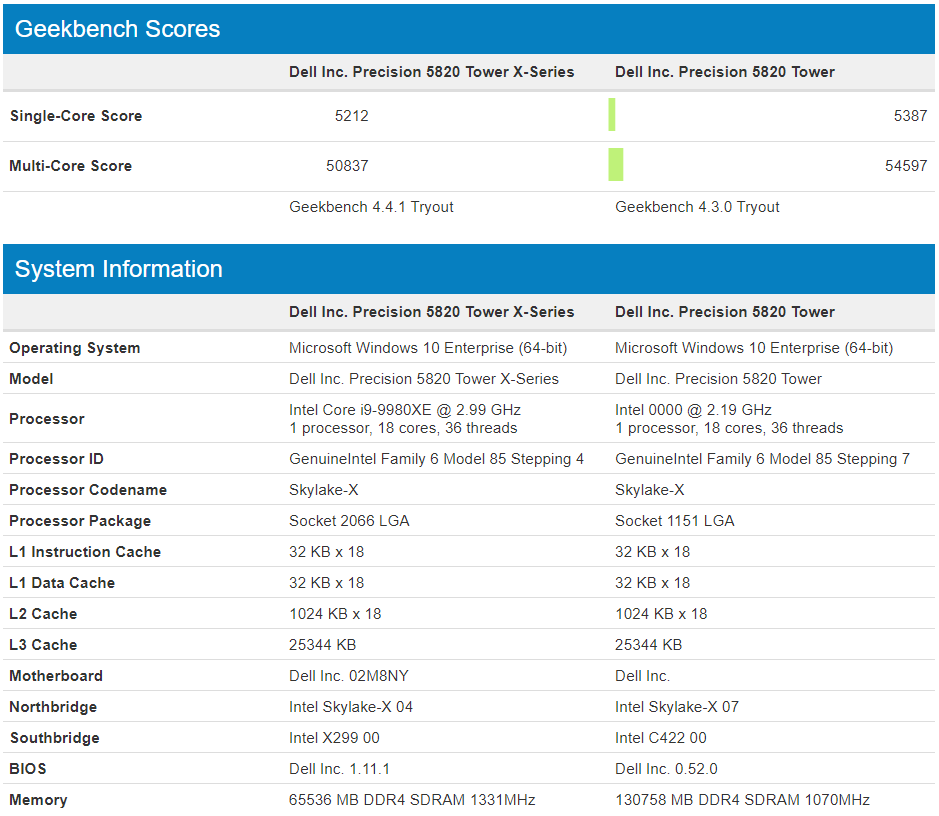Intel 18-Core Cascade Lake-X CPU Enters Geekbench 4 Database
Intel might not be quite ready to take the lid off its Cascade Lake-X (CSL-X) processors, but test results of the upcoming 14nm core-heavy chips have already started to show up at different parts of the Internet.
The first Cascade Lake-X leak dates back to April where we got the first glimpse of a 10-core chip which, in all likelihood, could be the direct replacement for the Intel Core i9-9900X, although it is noteworthy that this is likely pre-production silicon. That means these chips could be subject to change before they come to market, though they are obviously coming close.
Today, an unknown 18-core part going by the codename Intel 0000 has shown up in the Geekbench 4 database. Both the Skylake and Cascade Lake families fall under the Intel Family 6 Model 85 identifier. However, the Skylake carries the Stepping 4, and the leaked processor has the Stepping 7 identifier, which means it's a Cascade Lake chip.
| Row 0 - Cell 0 | Cores /Threads | Base /Boost (GHz) | L3 Cache(MB) | PCIe 3.0 | DRAM | TDP |
| Intel 0000* | 18 / 36 | 2.19 / 3.28 | 24.8 | ? | ? | ? |
| Core i9-9980XE | 18 / 36 | 3.00 / 4.40 | 24.75 | 44 | Quad DDR4-2666 | 165W |
| Core i9-7980XE | 18 / 36 | 2.60 / 4.20 | 24.75 | 44 | Quad DDR4-2666 | 165W |
*Specifications in the table are unconfirmed
The Intel 0000 processor comes equipped with 18 cores, 36 threads and 24.8MB of L3 cache. By the specifications alone, we can deduce that it's most likely the successor for Intel's current flagship Core i9-9980XE processor. Geekbench 4 registered the 18-core Cascade Lake part with a 2.19 GHz base clock and a 3.28 GHz maximum boost clock. The low operating clocks will surely raise many eyebrows but let's not forget that this Cascade Lake chip is probably a very early sample, and there's a big possibility that Geekbench 4 simply didn't identify the operating clocks correctly, or that the chip could still be being tuned. The detection error is evident when you look at the motherboard as Geekbench 4 seems to think that the Cascade Lake chip was housed on an LGA 1151 motherboard.
The 18-core Cascade Lake processor purportedly outperforms the Core i9-9980XE by 3.36% in single-core workloads and around 7.4% in multi-core workloads. This alone tells us that the previously detected operating clocks are inaccurate. Although the performance difference between the two generations of chips looks plausible, you should still take the results with a grain of salt. Being early silicon and all, there is still room for future improvement and tweakings.
Intel has already pushed out its Cascade Lake Xeon parts, however, there is no official release date for the Cascade Lake-X chips yet. Perhaps Intel is playing a waiting game with its rival AMD to see who launches its HEDT (High-End Desktop) processors first.
Get Tom's Hardware's best news and in-depth reviews, straight to your inbox.

Zhiye Liu is a news editor, memory reviewer, and SSD tester at Tom’s Hardware. Although he loves everything that’s hardware, he has a soft spot for CPUs, GPUs, and RAM.
-
jimmysmitty Interesting you didn't mention the chipset which was listed as an Intel C422 chipset. So it is LGA2066 and if its working on the C422 platform this is most likely a refresh and nothing major to even consider.Reply -
GetSmart For the actual clockspeed, add ".gb4" to the end of that Geekbench database link like this.Reply -
bit_user Reply
As far as I know, Cascade Lake is just a refresh of Skylake SP, with a couple hundred more 100 MHz and a couple hardware mitigations.jimmysmitty said:this is most likely a refresh and nothing major to even consider.
Heh, even the name is fitting. Like it cascaded down from Skylake.
: ) -
bit_user Reply
Okay, so we get:GetSmart said:For the actual clockspeed, add ".gb4" to the end of that Geekbench database link like this.
"processor_frequency": {
"minimum": 3978,
"maximum": 4480,
"median": 4433,
"mean": 4407,
"stddev": 86.391331606938024,
Except, then there's a list of "frequencies" that's 111 entries long. That's obviously not cores or threads, so I don't know exactly what to make of it.
But, it looks like maybe the part has a base of 4.0 GHz and max turbo of 4.5 GHz? Not bad. With Intel cranking it up so high, you can just smell their fear of the next ThreadRipper. -
jeremyj_83 Reply
Best question is what lie is Intel going to tell for this CPU's TDP. I bet they will say it is a 165W TDP when its normal TDP is closer to 300W.bit_user said:Okay, so we get:
"processor_frequency": {
"minimum": 3978,
"maximum": 4480,
"median": 4433,
"mean": 4407,
"stddev": 86.391331606938024,
Except, then there's a list of "frequencies" that's 111 entries long. That's obviously not cores or threads, so I don't know exactly what to make of it.
But, it looks like maybe the part has a base of 4.0 GHz and max turbo of 4.5 GHz? Not bad. With Intel cranking it up so high, you can just smell their fear of the next ThreadRipper. -
bit_user Reply
Well, it actually depends on the motherboard. If the motherboard strictly follows Intel's guidelines, then the steady state of the CPU will be at its specified TDP. However, you'll mostly see it running at or near its base clock speed, in that case.jeremyj_83 said:Best question is what lie is Intel going to tell for this CPU's TDP. I bet they will say it is a 165W TDP when its normal TDP is closer to 300W.
This article explains it quite clearly.
https://www.anandtech.com/show/13544/why-intel-processors-draw-more-power-than-expected-tdp-turbo
Enthusiast & gamer-oriented motherboards allow the CPU to run outside of Intel's specifications. Workstation and server boards generally do not (and certainly not by default). So, if you want it to stay within their specified TDP (which guarantees at least Base clocks), then choose your motherboard wisely.
Basically, it's not a lie, so much as an unspoken caveat or footnote. I'll agree that Intel really should do a better job of communicating what their TDP actually means, and when you can expect it to count. Likewise, we should expect motherboard vendors to make it clear when they're configured to exceed Intel's advertised TDP and how to keep within Intel's guidelines for users who care about that. -
GetSmart Not sure how Intel's new Cascade Lake-X (with up to 18 cores) is going to compete in the HEDT space since AMD's Threadripper has more cores (up to 32 cores) and much cheaper as well. Heck even Apple opted for Intel's 28-core Xeon line in their new Mac Pros.Reply -
bit_user Reply
Not well. And don't forget PCIe 4.0.GetSmart said:Not sure how Intel's new Cascade Lake-X (with up to 18 cores) is going to compete in the HEDT space since AMD's Threadripper has more cores (up to 32 cores) and much cheaper as well.
What Apple did was to go with Intel's server socket (LGA 3647), which Intel is now pushing for workstations, instead of the LGA 2066 on which they introduced the Skylake X-series and Xeon W.GetSmart said:Heck even Apple opted for Intel's 28-core Xeon line in their new Mac Pros.
The new Mac Pro's baseline CPU is certainly not 28-cores, though. I think they have 4 different CPU options, and going with the top-end 28-core model will probably add more to the workstation's price than the cost of a decent, small car.
One way I think Intel enticed Apple is by unlocking an extra 16 PCIe lanes, so they at least can match ThreadRipper's 64 lanes. Also, LGA 3647 has 6 memory channels, beating ThreadRipper's 4-channel support. Of course, Apple probably could've sweet-talked AMD into issuing a special, high-clocking, 32-core+ Epyc model, with all 8 memory channels enabled. -
jimmysmitty Replybit_user said:Not well. And don't forget PCIe 4.0.
What Apple did was to go with Intel's server socket (LGA 3647), which Intel is now pushing for workstations, instead of the LGA 2066 on which they introduced the Skylake X-series and Xeon W.
The new Mac Pro's baseline CPU is certainly not 28-cores, though. I think they have 4 different CPU options, and going with the top-end 28-core model will probably add more to the workstation's price than the cost of a decent, small car.
One way I think Intel enticed Apple is by unlocking an extra 16 PCIe lanes, so they at least can match ThreadRipper's 64 lanes. Also, LGA 3647 has 6 memory channels, beating ThreadRipper's 4-channel support. Of course, Apple probably could've sweet-talked AMD into issuing a special, high-clocking, 32-core+ Epyc model, with all 8 memory channels enabled.
The high clocking part is what I doubt. Considering on less cores AMD can't clock as high as Intel even with better cooling I doubt their 32 core TR is going to clock much better. Thats the only advantage Intel has in the consumer space is clock speed currently.
Hopefully they come up with something that is competitive in per core. -
bit_user Reply
The wildcard is that AMD is probably saving the highest binned parts. So, it could be that their 16-core Ryzen 3000 and the new ThreadRipper clock higher that what we've so far seen.jimmysmitty said:The high clocking part is what I doubt. Considering on less cores AMD can't clock as high as Intel even with better cooling I doubt their 32 core TR is going to clock much better. Thats the only advantage Intel has in the consumer space is clock speed currently.
But, with lower cost, lower power, PCIe 4.0, more cores, and more PCIe lanes, AMD only has to equal Intel's performance, for ThreadRipper to become the preferred workstation platform.

